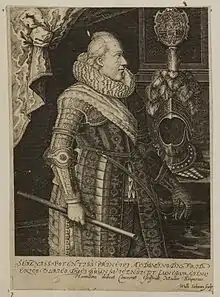Frederick Ulrich, Duke of Brunswick-Lüneburg
Frederick Ulrich (German Friedrich Ulrich, 5 April 1591 – 11 August 1634), Duke of Brunswick-Lüneburg, was prince of Wolfenbüttel from 1613 until his death.
Frederick Ulrich | |
|---|---|
| Duke of Brunswick-Lüneburg, Prince of Brunswick-Wolfenbüttel | |
 | |
| Born | 5 April 1591 Wolfenbüttel |
| Died | 11 August 1634 (aged 43) Brunswick |
| Noble family | House of Guelph |
| Spouse(s) | Anna Sophia of Brandenburg |
| Father | Henry Julius, Duke of Brunswick-Lüneburg |
| Mother | Elizabeth of Denmark |
Life
Frederick Ulrich was the son of Duke Henry Julius of Brunswick-Wolfenbüttel and his second wife Princess Elisabeth of Denmark, the eldest daughter of King Frederick II of Denmark. Frederick studied at the universities of Helmstedt and Tübingen.
England in 1610
In March 1610 he visited his aunt Anne of Denmark in England, staying at St James Palace with Prince Henry, who took him to see the ship the Prince Royal being built at Woolwich.[1] He took a tour of the South West, visiting Oxford, Gloucester, Bath, and Bristol where news of the assassination of Henry IV of France reached him and ended his tour. The poet Sir David Murray, a gentleman of the household of Prince Henry, managed part of the tour, using £1,000 for expenses. He attended the masques London's Love to Prince Henry and Tethys' Festival.[2] In April he performed in a tournament "running at the ring."[3] The Prince of Wales gave him his portrait painted by Isaac Oliver. James VI and I gave him a jewel and a ring which the duke gave to Princess Elizabeth, bought for £1,900 from Peter Vanlore. After Prince Henry's death in 1612 the duke was sent a suit of gilt armour.[4]
Duke of Brunswick-Lüneburg
He became ruling duke after the death of his father in 1613. In 1615, Frederick became involved in a war with the City of Brunswick, which was reluctant to recognize his overlordship.
Between 1616 and 1622, he was de facto deposed by his mother, Elizabeth, with the help of her brother, King Christian IV of Denmark, because of his alcoholism; government business was led by Anton von Streithorst, who nearly ruined the state by minting coins from cheap metals and thus causing inflation. Because of the bad situation of the state, Christian had Frederick take control of the government again. With the help of the states' nobility, he managed to regain control; the members of the Streithorst government fled the state.
Because of Frederick's indecision and weakness, Brunswick was heavily ransacked during the Thirty Years' War — both by the Catholic forces of Tilly and Pappenheim and by the Protestant forces of Christian of Denmark and Gustavus Adolphus of Sweden. The duke lost most of his territory during this time. He died after an accident in 1634. The principality was eventually ceded to Augustus the Younger in 1635.
Marriage and family
Frederick Ulrich married Anna Sophia (1598-1659), daughter of John Sigismund, Elector of Brandenburg, in 1614. They had no children and Frederick tried to get a divorce from Anna, though he died before the divorce was completed. Anna Sophia spent her widowhood in Schöningen, where she founded a renowned school, the Anna-Sophianeum.
Ancestors
| Frederick Ulrich, Duke of Brunswick-Lüneburg | Father: Henry Julius |
Paternal Grandfather: Julius |
Paternal Great-grandfather: Henry V |
| Paternal Great-grandmother: Mary of Württemberg | |||
| Paternal Grandmother: Hedwig of Brandenburg |
Paternal Great-grandfather: Joachim II Hector | ||
| Paternal Great-grandmother: Hedwig Jagiellon | |||
| Mother: Elizabeth of Denmark |
Maternal Grandfather: Frederick II of Denmark |
Maternal Great-grandfather: Christian III of Denmark | |
| Maternal Great-grandmother: Dorothea of Saxe-Lauenburg | |||
| Maternal Grandmother: Sofie of Mecklenburg-Schwerin |
Maternal Great-grandfather: Ulrich III of Mecklenburg-Schwerin | ||
| Maternal Great-grandmother: Elizabeth of Denmark |
References
- Henry Ellis, Original Letters Illustrative of English History, 3rd Series, vol. 4 (London, 1846), p. 167.
- Norman McClure, Letters of John Chamberlain, vol. 1 (Philadelphia, 1939), p. 300: John Nichols, The Progresses, Processions, and Magnificent Festivities, of King James the First, vol. 2 (London, 1828), pp. 290, 310-2, 314: CSP Domestic: 1603-1610, p. 611.
- E. K. Purnell & A. B. Hinds, HMC Downshire, vol. 2 (London, 1936), p. 276.
- William Brenchley Rye, England as Seen by Foreigners in the Days of Elizabeth & James the First (London, 1865), pp. 59, 224-5.
External links
- Allgemeine Deutsche Biographie, vol. 7, p. 501-505.
- At the House of Welf site